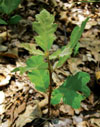-
Hantavirus Pulmonary Syndrome Response Continues at Yosemite National Park
The recent diagnosis of hantavirus pulmonary syndrome (HPS) in several park visitors has prompted Yosemite National Park to scale up public health response and outreach. More »
Nature & Science

The Merced River, pictured here at Vernal Fall, is not just a spectacular geologic feature but a home to Yosemite's plants and animals. “It is by far the grandest of all the special temples of Nature I was ever permitted to enter.” —John Muir Yosemite National Park, which boasts nearly 95 percent designated Wilderness, is a 195-mile escape from urban San Francisco or a 315-mile journey from Los Angeles. The expansive park’s 747,956 acres or 1,169 square miles are home to hundreds of wildlife species and thousands of Yosemite plants. Designated a World Heritage Site in 1984, Yosemite is known for its granite cliffs, waterfalls, clear streams, giant sequoia groves and biological diversity. Two Wild & Scenic Rivers, the Tuolumne and Merced rivers, begin in the park and flow west to the Central Valley. Visitors experience the park's 800 miles of hiking trails and 282 miles of road. Animals: Yosemite supports more than 400 species of vertebrates, including fish, amphibians, reptiles, birds, and mammals. Insects abound as well, with the recent discovery of two species not believed to exist anywhere else in the world. The high diversity of animal species falls in line with striking elevational gradient and topographic variability of the park. 
Black oak Plants: Move up or down in elevation and feel as though you are in another park. Vegetation changes from oak woodlands to chaparral scrublands to lower montane to upper montane to subalpine to alpine. Those who step into the alpine zone can see krummholz whitebark pines and perhaps a western juniper or mountain hemlock. Scientists study many individual plants, including the black oak, to understand its future challenges. Natural Features and Ecosystems: Yosemite is a scientific laboratory of hydrology, geology and glaciology, amongst other sciences. Visitors fall in love with the park's many waterfalls, specifically 2,425-foot Yosemite Falls that ranks as the tallest in North America, flowing down into the scenic Valley meadows. Hikers take notice of the enormous granite mountains from the 8,842-foot Half Dome to the 13,114-foot Mt. Lyell-Yosemite's tallest peak. Glaciers, which John Muir sought out in California as well as Alaska, add into the mix with the Maclure and Lyell still intact. And, mapping all of this wonder is the task of GIS-skilled park scientists. Environmental Issues: Yosemite can be affected by issues, many of which originate outside the park, like air quality and climate change. Yosemite's environment is healthy in many ways: Visitors use their senses in Yosemite to see the breath-taking scenic vistas, hear the soundscape and almost touch the dark night sky above. Restoration projects prevent unnatural growth in open areas to retain the historic views for which Yosemite is known. Also, fire, natural or prescribed, maintains viewsheds by preventing an unsafe undergrowth in places that it should not be.
Research and Studies: A plethora of ongoing scientific research abounds at Yosemite from declining animal species studies to invasive plant removal strategies to human carrying capacity issues. Yosemite has been building its Resource Management and Science capabilities, expanding its staff to more than 100. The division serves as a public meeting place for scientific symposiums (topics include fire science, hydroclimatology, archeology, and bird surveys). In January 2011, the division launched the Yosemite Science publication, an online resources management publication that presents recent and ongoing research. In addition, the division processes hundreds of research permits every year for its staff and outside interests. And, Yosemite is proud to sponsor the first park-based social science branch, which serves as a model for ground-breaking work in visitor-use and user-capacity issues. Also, learn more about how Yosemite's scientists work on a regional level through Inventory & Monitoring.

TWITTER: Yosemite's natural & cultural resource news at http://twitter.com/YosemiteScience. You do not need an account simply to view our daily postings. |
Did You Know?

Natural fires in Yosemite are often no more than a single burning snag (standing dead tree) or a slow moving, low intensity fire that cleans underbrush from the forest floor. These fires prevent unwanted fires by removing accumulating forest debris that can fuel a larger fire in hot, dry conditions.

 Now in Bloom
Now in Bloom
 Attend the Yosemite Forum
Attend the Yosemite Forum